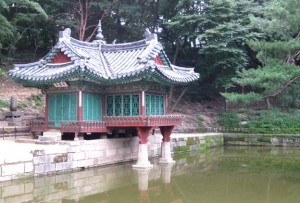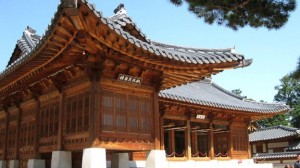Here at WoWasis, we’re history enthusiasts, and love going to old palaces, temples, ruins, you name it. Seoul has suffered her share in various wars, and to a very large extent, it’s a modern city. Nevertheless, Seoul does have a number of palaces worth visiting, with compelling architecture reflective of varying degrees of restoration.
We’d suggest, in this order of importance, a visit to the following palaces and shrines: Changdeokgung, Gyongbokgung, Jong Myo Shrine, Deoksugung, and Gyonghuigung. The first three are all within easy walking distance of the Anguk metro station. Gyongbukgung to the west, Changdeokgung to the east, and Jong Myo (which actually isn’t a palace, but a shrine) is to the south of Changdeokgung. When you buy your entrance tickets to these sites, be sure to pick up the free English guide pamphlets adjacent to the ticket booths. They are well-written and essential to understanding what you’re seeing. For the convenience of visitors wishing to see both the Changdeokgung and Gyongbokgung palaces, the former is closed on Monday, the latter on Tuesday.
1) Changdeokgung Palace was constructed in 1405. The Secret Garden, its highlight, and requires a separate entrance. There are English guided tours three times per day (see the schedule below), but on Thursdays between April and November, you can go unescorted. The garden is fascinating, with a magnificent pavilion overlooking a lily pond, and many other ornate buildings and ponds set on a breathtakingly beautiful hillside setting. Usually, we here at WoWasis like to avoid formal tours, but the English guided tour was wonderful. The guide was knowledgeable, and the stories behind the structures and ponds were worth hearing. When you arrive at the Palace, we recommend that you book your tour for the Secret Garden immediately. Between your arrival and your tour time, you can visit the magnificent palace and other structures.
Chandeogung Palace and Secret Garden
Open Tuesday-Sunday
April-October 9:00-6:30
Dec-Feb 9:00-5:00
Nov – Mar 9:00-5:30
English Tours of the Secret Garden: 11:30, 1:30, 3:30 (90 minutes in length)
2) Gyeongbokgung Palace and environs are immense, and include two museums. The National Palace Museum, which houses robes, jewlry, and artifacts related to Joseon royalty, is immediately to your left as you enter the palace grounds, or you can enter separately, as admission is free. The National Folk Museum is also free but only as an adjunct to your paid admission to the palace. The Folk Museum is huge, worthwhile seeing, but a challenge to navigate. Plan on two or three hours to see the palace and grounds and another two to three hours to fully investigate the museums. The changing of the guard ceremony occurs outside the main gate hourly, from 10 am – 4 pm
The palace was built in 1395 and served as Korea’s main palace for more than 500 years. It was burned by Japanese invaders in 1592 and left derelict until 1867, when it was rebuilt, consisting of some 500 buildings. As the palace was the symbol of national sovereignty, 90% of the palace and buildings were destroyed by the Japanese occupying forces in 1915, an act which will never be forgiven by Koreans. Restoration of Gyeongbokgung was begun in 1990, and remains in effect today.
Among the most interesting sights are the two-story Geunjeongjeon palace building and the Gyeonghoeru, which rests on piers and overlooks a pond. Do not fail to see the intricately beautiful Hyangwonjeong pavilion, which rests serenely in the middle of the Hyangwonji pond. And for a real treat, visit the Taewonjeon complex to the far left rear of the palace grounds. Here, busloads of screaming schoolchildren rarely emerge, and one gets the sense of the peace and quiet that once permeated the royal grounds.
Gyeongbokgung Palace
Open Wednesday-Monday
March-Oct: 9 am – 6 pm
Nov-Feb: 9 am – 5 pm
3) The Jongmyo Shrine is an exquisite World Heritage-listed site just to the south of Changdeokgung Palace. It houses the spirit tablets of Joseon royalty and their servants, and is a pleasant respite from the general hubbub of busy Seoul. Among the more fascinating elements of Jongmyo are the traditional processions and rituals that are held there. Just outside, local citizens gather to play games such as janggi and baduk, and take calligraphy and painting lessons, providing the visitor with a welcome non-touristy view of Seoul customs.
Jongmyo Shrine
Open Sunday-Monday
March-Sept: 9 am – 6 pm
Oct-Feb: 9 am – 5:30 pm
4) Deoksugung Palace is located just across the street from Seoul City Hall, and has a number of buildings of varying architectural styles, including the neoclassical Seokjojeon. Deoksugung served as the main palace of the Great Han Empire (1897-1910) and was built ca. 1593. There is a fascinating changing of the guard ceremony several times a day (10:30, 2 pm, 3 pm) from February through December, in which more than 50 participants dress in period costumes and play period musical instruments.
Deoksugung Palace
Open Tuesday-Sunday
9 am – 9 pm
5) Gyeonghuigung Palace is a short walking distance from the Gwanghwamun metro stop and is in an austere setting, away from most of Seoul’s other attractions (the Seoul Museum of History, though, is right next door). It was a villa for Joseon royalty, and its buildings have beautiful woodwork. A great part of its fascination lies in the fact that it’s off the tourist beat and offers refreshingly quiet, reflective moments to the visitor.
Gyeonghuigung Palace
Open Tues-Sat: 9 am – 6 pm, Sunday 10 am – 6 pm






Leave a Reply